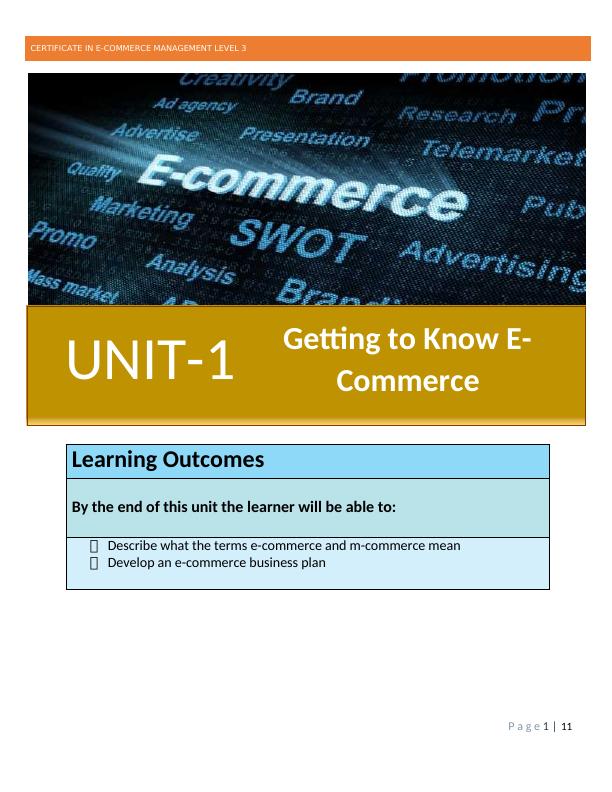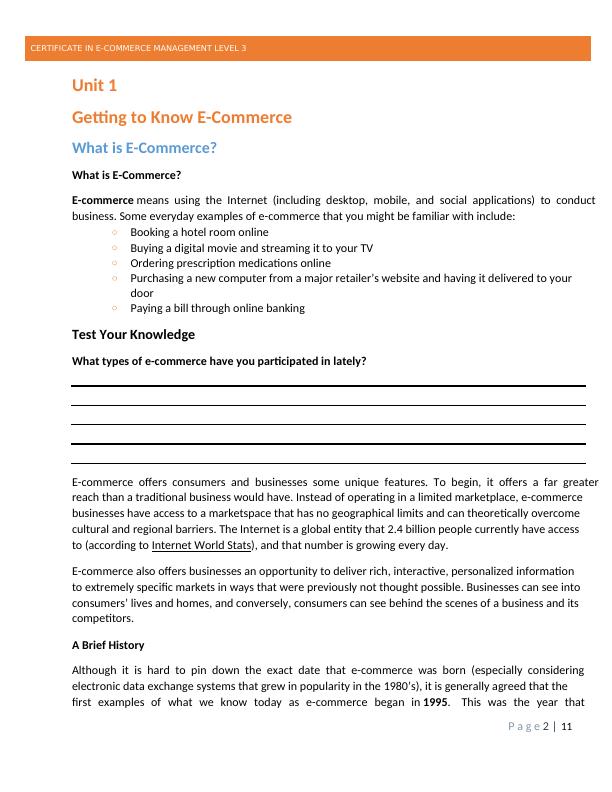UNIT-1 Getting to Know ECommerce
11 Pages2619 Words109 Views
Added on 2020-11-30
UNIT-1 Getting to Know ECommerce
Added on 2020-11-30
ShareRelated Documents
CERTIFICATE IN E-COMMERCE MANAGEMENT LEVEL 3P a g e 1 |113Learning OutcomesBy the end of this unit the learner will be able to:Describe what the terms e-commerce and m-commerce meanDevelop an e-commerce business planUNIT-1Getting to Know E-Commerce

CERTIFICATE IN E-COMMERCE MANAGEMENT LEVEL 3P a g e 2 |11Unit 1Getting to Know E-CommerceWhat is E-Commerce?What is E-Commerce?E-commerce means using the Internet (including desktop, mobile, and social applications) to conductbusiness. Some everyday examples of e-commerce that you might be familiar with include:Booking a hotel room onlineBuying a digital movie and streaming it to your TVOrdering prescription medications onlinePurchasing a new computer from a major retailer’s website and having it delivered to yourdoorPaying a bill through online bankingTest Your KnowledgeWhat types of e-commerce have you participated in lately?E-commerce offers consumers and businesses some unique features. To begin, it offers a far greaterreach than a traditional business would have. Instead of operating in a limited marketplace, e-commercebusinesses have access to a marketspace that has no geographical limits and can theoretically overcomecultural and regional barriers. The Internet is a global entity that 2.4 billion people currently have accessto (according to Internet World Stats), and that number is growing every day.E-commerce also offers businesses an opportunity to deliver rich, interactive, personalized informationto extremely specific markets in ways that were previously not thought possible. Businesses can see intoconsumers’ lives and homes, and conversely, consumers can see behind the scenes of a business and itscompetitors.A Brief HistoryAlthough it is hard to pin down the exact date that e-commerce was born (especially consideringelectronic data exchange systems that grew in popularity in the 1980’s), it is generally agreed that thefirst examples of what we know today as e-commerce began in 1995. This was the year that

CERTIFICATE IN E-COMMERCE MANAGEMENT LEVEL 3P a g e 3 |11advertisements first started to appear on the Internet, which was a new phenomenon at that time. E-commerce was quite primitive, with businesses focused on simple displays of their products. Featureswere limited due to narrow bandwidth that barely supported images, let alone data-rich elements suchas music and video.In the early years of the 21stcentury (from 2000 to 2004), the dot-com bubble burst, sending many e-commerce and technology companies into bankruptcy. Businesses became more cautious about theInternet, meaning that most companies focused on using the Internet for marketing and advertising.However, during this period high-speed Internet also became more readily available and e-mail becamemore widely used. As new technologies developed, the Internet grew, too, and businesses started re-evaluating e-commerce.Subsequent years (from 2005-2010) brought devices like the iPhone and tablets to the market. Socialnetworks like Facebook and Twitter gathered users exponentially. The Internet expanded beyonddesktops and into the mobile world. Increasingly, businesses are moving to where customers are: online.(Did you know that in the U.S., 89% of Internet users have shopped online? This number varies aroundthe world but is growing in all countries.)There is no doubt that e-commerce is a growing industry. For example, although e-retail sales generated$259 billion in revenue in the United States in 2013, it only accounts for 6% of the $3.8 trillion generatedby the U.S. retail industry. Businesses must stay on top of trends and new developments and adjust theire-commerce strategy accordingly.Test Your KnowledgeWhy Do Customers Buy Online?As business owners, it’s important to understand what our customers need and want. A fundamentalpart of this is understanding why customers buy online.Why do you buy online?Here are the top answers to this crucial question, based upon a 2011 survey by eMarketer.Convenience (online stores are open 24 hours and it is easier to compare information)Easier to compare pricesFree shipping and/or cheaper sales taxNo crowdsEasier to find what they are looking forMore variety in products

CERTIFICATE IN E-COMMERCE MANAGEMENT LEVEL 3P a g e 4 |11The Six ModelsWe can break down e-commerce into six major models.As you go through the models below, consider examples that you have encountered.Test Your KnowledgeBusiness to Business (B2B)Businesses sell products or services directly to other businesses over the Internet. Acklands Grainger (anindustrial supply business) and Salesforce (a sales-focused software company) are two examples of B2Be-commerce companies. B2B e-commerce transactions generated about $4.7 trillion in the United Statesalone in 2013.Note: We include business to government e-commerce (B2G) in this category.Business to Consumer (B2C)Businesses sell products or services to consumers over the Internet. Amazon is one of the world’s biggestB2C e-commerce businesses. Other examples include:DellNetflixAppleJ.C. PenneyZazzleB2C e-commerce is the second largest type; in 2013, it generated $419 billion in the United States alone.Consumer to Consumer (C2C)Consumers sell directly to other consumers over the Internet. eBay and Etsy provide these types ofservices, for example. C2C e-commerce is far smaller than B2B or B2C commerce, but still generated over$90 billion globally in 2013.

End of preview
Want to access all the pages? Upload your documents or become a member.
Related Documents
E-commerce Business Management Certificationlg...
|28
|4951
|126
Overview of E-Commercelg...
|12
|2100
|151
E-Business and E-Commerce: Their Roles in Today's Business Worldlg...
|5
|1717
|146
Ecommerce Migration: Assignmentlg...
|13
|4295
|51
Role of E-commerce in making advertising more attractive and authentic to the consumer: A study on Argoslg...
|4
|1467
|234
Advantages and Disadvantages of Location Based Advertising Communicationlg...
|12
|3944
|74
